
Pleurogona is an order of tunicates which is no longer in use as it contains the same families as Stolidobranchia.

Clavelina is genus of sea squirts, containing the following species:
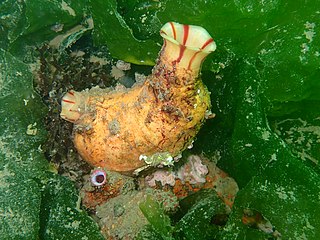
Microcosmus sabatieri, commonly called the grooved sea squirt, sea fig, or violet, is a species of tunicates. The species has a rocky-shape appearance. It is mainly found in the Mediterranean Sea. It is used as food in parts of Europe.

Phlebobranchia is an order of sea squirts in the class Ascidiacea, first described by Fernando Lahille in 1886.

Diazonidae is a family of sea squirts belonging to the order Aplousobranchia.
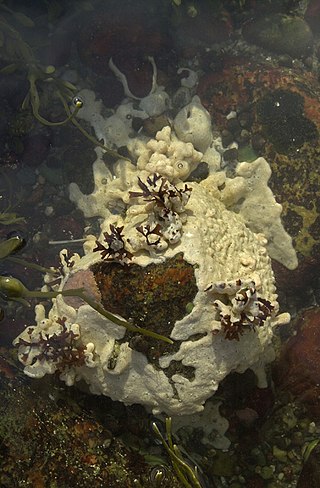
Aplousobranchia is an order of sea squirts in the class Ascidiacea, first described by Fernando Lahille in 1886. They are colonial animals, and are distinguished from other sea squirts by the presence of relatively simple pharyngeal baskets. This provides the etymology of their name: in ancient greek, ἁ.πλοος-ους (ha.ploos-ous) means "simple". The posterior part of the abdomen contains the heart and gonads, and is typically larger than in other sea squirts.
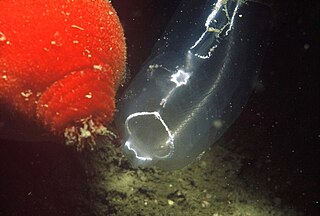
Clavelina sabbadini is a species of tunicate, in the genus Clavelina. Like all ascidians, these sessile animals are filter feeders.

Pycnoclavella diminuta, known as the white-spotted sea squirt, white-spot ascidian, and white-spotted ascidian, is a species of tunicate, in the genus Pycnoclavella. Like all ascidians, these sessile animals are filter feeders.

Ascidiella aspersa, the European sea squirt, is a species of solitary sea squirts native to the northeastern Atlantic, from the Mediterranean Sea to Norway. They possess oval bodies up to 50 to 130 mm in length. Their branchial siphons are conical and positioned at the top of the body. They possess six to eight lobes. The atrial siphons are located at the upper third of the side of the body and possess six lobes. The body is covered by a firm transparent test that is greyish to brown in color. The test often snag detritus that remain loosely attached to the animal. When expanded, at most 40 tentacles can be observed on the inside surface of the branchial wall. Both the openings of the branchial and atrial siphons possess lighter colored ridges on their rims. They may also be frilled at times. A. aspersa are attached to the substrates by the left side of their bodies. They can be found in dense groups of unfused individuals on hard surfaces like rocks. at depths of up to 90 m (300 ft).

Ascidia mentula is a species of solitary tunicate. It is found in the north east Atlantic Ocean, the Mediterranean Sea and Black Sea. It occurs round the coasts of Britain but is seldom seen on the east coast of England or Scotland.
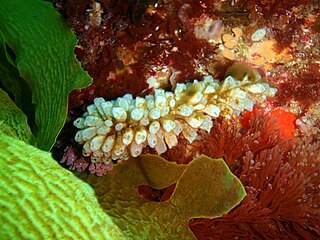
Clavelina cylindrica is a species of tunicate in the genus Clavelina. It is found in shallow waters around Australia.

Diazona violacea is a species of tunicate, an ascidian in the family Diazonidae. It is the type species of the genus Diazona.

Polycarpa pomaria is a species of tunicate or sea squirt in the family Styelidae. It is native to the northeastern Atlantic Ocean where it lives on the seabed at depths down to about 450 metres (1,500 ft).

Dendrodoa is a genus of ascidian tunicates in the family Styelidae.

Dendrodoa grossularia is a species of tunicate or sea squirt in the family Styelidae, commonly known as the baked bean ascidian. It is native to the northeastern Atlantic Ocean where it is common in shallow water and on the lower shore in exposed rocky sites.
Polycarpa scuba is a species of tunicate or sea squirt in the family Styelidae. It is native to the northeastern Atlantic Ocean where it lives on the seabed.
Stolonica socialis is a species of tunicate or sea squirt in the family Styelidae, commonly known as orange sea grapes. It is native to the northeastern Atlantic Ocean, where it lives on the rocky seabed in shallow water.

Distomus variolosus is a species of tunicate or sea squirt in the family Styelidae. It is native to the northeastern Atlantic Ocean where it lives on the seabed, typically on the stems and fronds of kelp.
Rhizomolgula is a genus of ascidian tunicates in the family Molgulidae.
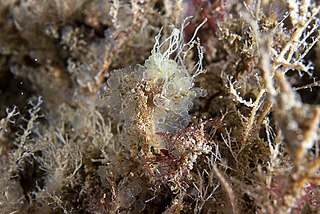
Perophora listeri is a species of colonial sea squirt in the genus Perophora, native to the North Atlantic.

















